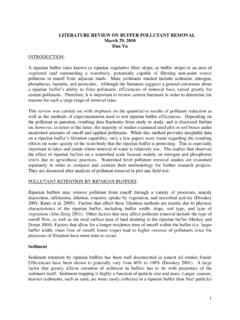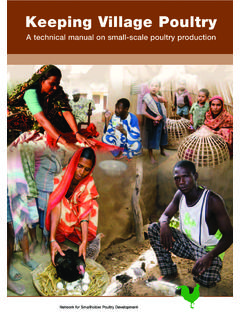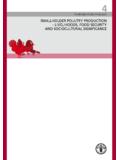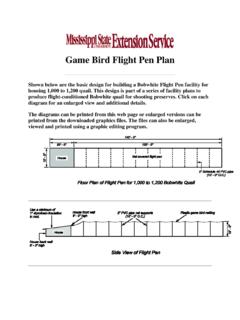Transcription of POULTRY Production - Texas A&M University
1 POULTRY . POULTRY Production B est M anagement P ractices (BMPs). endorsed by TABLE OF WHY BMPS ARE. CONTENTS IMPORTANT TO LOUISIANA. Introduction .. 3. Nutrient Management .. 5 In Louisiana we are blessed with beautiful and Pesticide Management .. 14 abundant waters to enjoy fishing, hunting, boating or just relaxing on the shore of a lake, river or bayou. Most of Management of POULTRY the water in Louisiana's rivers and lakes comes from Mortality .. 19 rainfall runoff. As this runoff travels across the soil sur- face, it carries with it soil particles, organic matter and General Farm BMPs .. 29. nutrients, such as nitrogen and phosphorus. Agricultural activities contribute to the amount of these materials entering streams, lakes, estuaries and groundwater. In addition to assuring an abundant, affordable food supply, Louisiana farmers must strive to protect the environ- ment.
2 Research and educational programs on environ- mental issues related to the use and management of natural resources have always been an important part of the LSU AgCenter's mission. Working with representa- tives from the agricultural commodity groups, the Natu- ral Resources Conservation Service (NRCS), the Louisi- ana Department of Environmental Quality (LDEQ), the Louisiana Farm Bureau Federation (LFBF) and the Loui- siana Department of Agriculture and Forestry (LDAF), the LSU AgCenter has taken the lead in assembling a group of Best Management Practices (BMPs) for each agricultural commodity in Louisiana. BMPs are used by agricultural producers to control the generation or delivery of pollutants from agricultural activities to water resources of the state, thereby preventing degradation of surface and ground- water.
3 2. INTRODUCTION. POULTRY Production is the References are made to largest animal industry in Louisi- specific NRCS Production codes ana. It consists of a vertically that are explained in the text. integrated broiler industry and a More detailed information about commercial egg industry. The these practices can be found in broiler industry is the largest in the NRCS Field Office Technical both numbers and income. Most Guide (FOTG), which can be POULTRY commercial broiler Production is found in all Soil and Water in 10 of the northern parishes. Conservation District Offices, all In POULTRY Production , there NRCS field offices and on the are issues of special concern to NRCS web page. Additionally, the environment. Therefore, these under voluntary participation by Best Management Practices the producer, technical assistance (BMPs) focus on three main to develop and implement a areas: Nutrient Management, farm-specific Conservation Plan Pesticide Management and is available through the Conser- Mortality Management.
4 Each vation districts, NRCS field area is discussed and the environ- offices and the LSU AgCenter mental concerns associated with parish offices. them identified. Possible alterna- BMPs tive practices are introduced that, when implemented, reduce the impact of POULTRY Production on the environment. POULTRY Production BMPS 2000 3. The following additional conservation practices apply to POULTRY Production . The practices and the NRCS. Production codes are listed. Filter Strips Grassed Waterways (NRCS Code 393) (NRCS Code 412). These are strips or areas of These are natural or con- vegetation for removing sedi- structed channels that are shaped ment and other pollutants from or graded to required dimensions runoff. Areas are on the lower and established in suitable edge of fields or above conser- vegetation for the stable convey- vation practices such as terraces ance of runoff.
5 They are designed or diversions or on fields adja- to convey runoff without causing cent to streams, ponds and erosion or flooding and to im- lakes. prove water quality. These Production practices are not covered in detail in this Field Borders publication, but they are impor- (NRCS Code 386) tant in POULTRY operations. For These are strips of peren- more information on these nial vegetation established at practices and how to implement the edge of fields. They control them, contact your local NRCS. erosion and protect edges of or Conservation District Office. fields that are used as turnrows or travel lanes for farm machinery. 4 POULTRY Production BMPS 2000. NUTRIENT. NUTRIENT MANAGEMENT. Sediment MANAGEMENT. Management in Surface Water Introduction A sound soil fertility pro- Nitrogen soil water and readily available gram is the foundation upon for plant uptake.
6 The ammonium which a profitable farming Nitrogen (N) is a part of all form is attracted to and held by business must be built. Agricul- plant and animal proteins. There- soil particles, so it does not tural fertilizers are a necessity for fore, human survival depends on readily leach through the soil producing abundant, high quality an abundant supply of N in with rainfall or irrigation water. food, feed and fiber crops. Using nature. Approximately 80 percent Nitrates, on the other hand, are fertilizer nutrients in the proper of the atmosphere is nitrogen not attached to soil particles and amounts and applying them gas. Most plants cannot use this do move downward with soil correctly are both economically form of nitrogen, however, and water and can be leached into and environmentally important to supplemental nitrogen must be groundwater or run off into the long-term profitability and supplied through the soil.
7 A crop surface waters. sustainability of crop Production . well supplied with N can pro- Excessive nitrate concentra- The fertilizer nutrients that have duce substantially higher yields, tions in water can accelerate potential to become groundwater on the same amount of water, algae and plant growth in N. or surface water pollutants are than one deficient for N. Further- streams and lakes, resulting in nitrogen and phosphorus. In more, properly fertilized crops oxygen depletion. Nitrate con- general, other commonly used use both N and water more centrations above a certain level fertilizer nutrients do not cause efficiently, thus improving in drinking water may be hazard- concern as pollutants. environmental quality and profit- ous to the health of some ani- ability. Because erosion and runoff mals or human infants. are the two major ways nonpoint- Supplemental N is neces- source pollutants move into sary on almost all non-legume Phosphorus surface water resources, practices crops in Louisiana for maximum Phosphorus (P), like nitro- that reduce erosion or runoff are profits.
8 Producers should follow gen, is essential for plant growth. considered Best Management N recommendations based on Naturally occurring P exists in a Practices (BMPs). Similarly, Louisiana research. These recom- phosphate form either as soluble practices that limit the buildup of mendations take into account inorganic phosphate, soluble nutrients in the soil, which can maximum economic yield poten- phosphate, particulate phosphate leach to groundwater or be tials, crop variety, soil texture or mineral phosphate. The min- P. picked up in runoff, and practices and area of the state. Nitrogen eral forms of phosphorus (cal- that ensure the safe use of agri- recommendations from the LSU cium, iron and aluminum phos- cultural chemicals also are AgCenter are usually ample to phates) are low in solubility. The considered BMPs.
9 In general, provide optimum economic amount of these elements (cal- soil conservation and water yields. cium, iron and aluminum). quality protection are mutually Decomposition of organic present in reactive forms varies beneficial; therefore the BMPs matter results in simpler inor- with different soils and soil described here are the best means ganic N forms such as ammo- conditions. of reducing agricultural nonpoint nium (NH4+) and nitrate (NO3-). source pollution resulting from These forms of N are soluble in fertilizer nutrients. POULTRY Production BMPS 2000 5. NUTRIENT MANAGEMENT. The immediate source of phosphorus for plants is that which is dissolved in the soil solution. Phosphate is absorbed from the soil solution and used by plants. A. soil solution containing only a few parts per million of phosphate is usually considered adequate for plant growth.
10 Phosphate used by plants is replaced in the soil solution by soil minerals, soil organic matter decompo- sition or applied fertilizers. Phosphate is not readily soluble. Most of the ions are either used by living plants or adsorbed to sediment, so the potential of their leaching to groundwater is low. That portion of phosphate bound to sediment particles Algae bloom is virtually unavailable to living organisms, but it becomes available as it detaches from sediment. Only a small part of the phosphate moved with sediment into surface water is immediately available to aquatic organisms. Additional phosphate can become available slowly through biochemical reactions, however. The slow release of large amounts of phosphate from sediment layers in lakes and streams could cause excessive algae blooms and excessive growth of plants, thereby affecting water quality.










